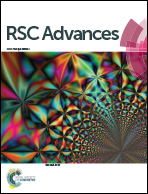A copper(ii)–thioamide combination as a robust heterogeneous catalytic system for green synthesis of 1,4-disubstituted-1,2,3-triazoles under click conditions†
Abstract
An efficient and practical synthesis of 1,4-disubstituted-1,2,3-triazoles under click conditions using a copper(II)–thioamide combination as an efficient heterogeneous catalyst is disclosed. Mild reaction conditions and high yields make this method an attractive option for the preparation of triazole derivatives. The key to this procedure was the generation of Cu(I) required for the azide-alkyne cycloaddition, which was achieved by in situ reduction of Cu(II) using thiobenzanilide as reduction agent and ligand.


 Please wait while we load your content...
Please wait while we load your content...